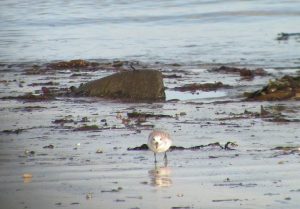Wednesday 13th September dawned bright and sunny despite warnings of heavy rain showers. The lagoon at the railway station had a good variety of birdlife including Lapwing, Little Grebe, Little Egret and Grey Heron.
The train took us to Glynn Halt where the Glynn River flows into Larne Lough, creating a mini estuary accessed by birds and wildlife. First scan found a large number (50+) of Red-breasted Merganser feeding busily off shore. We could hear the hauntingly beautiful call of Curlews on the shore feeding alongside Oystercatcher, Redshank and Greenshank. A Hooded Crow was flying up again and again, dropping a mussel on the rocks trying to break the shell.
The train took us to Glynn Halt where the Glynn River flows into Larne Lough, creating a mini estuary accessed by birds and wildlife. First scan found a large number (50+) of Red-breasted Merganser feeding busily off shore. We could hear the hauntingly beautiful call of Curlews on the shore feeding alongside Oystercatcher, Redshank and Greenshank. A Hooded Crow was flying up again and again, dropping a mussel on the rocks trying to break the shell.
The train brought us back to Larne and we drove to Sandy Bay where a shoal of fish was causing a feeding frenzy off shore. Herring, Great Black-backed, Common and Black-headed Gulls vied with Gannets, Shags and Cormorants for the silver beauties. Razorbills, Black Guillemots and Guillemots formed another foraging group. On the shore Ringed Plover, Turnstone, Dunlin and a single Sanderling were joined by a vocal group of Sandwich Tern, their grating “Kerr-it” call contrasting with the gentle “Too-wip” of the Ringed Plover.
The arrival of the ferry was our signal to return home after a grand day out.
No.of species 34

The arrival of the ferry was our signal to return home after a grand day out.
No.of species 34

D’s Sanderling Sandy Bay

